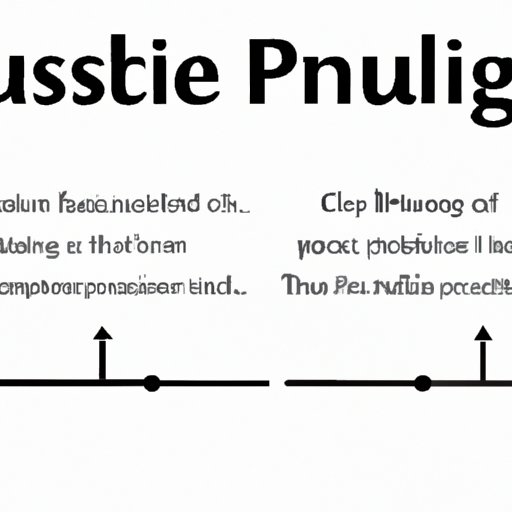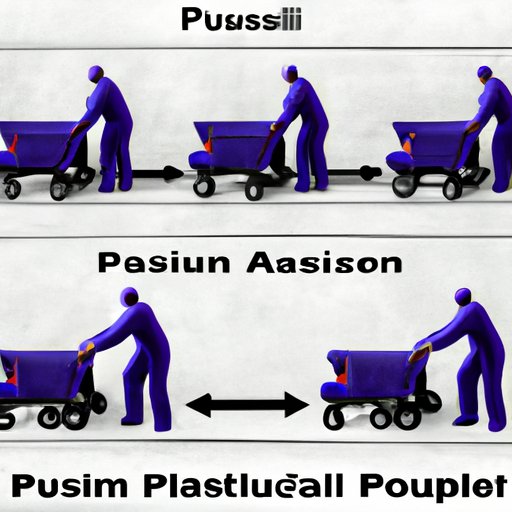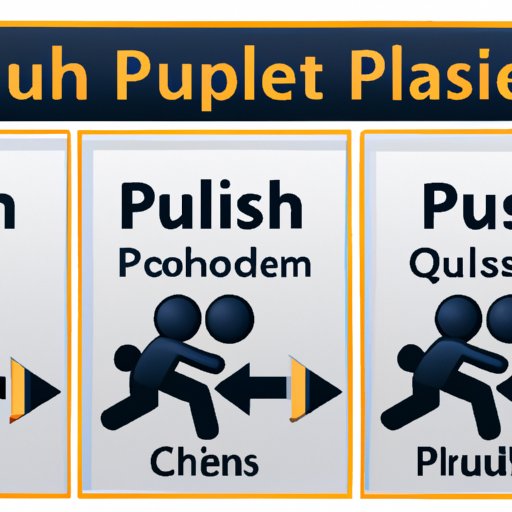Introduction
Supply chain management is a complex process that involves a wide range of activities, from procurement to distribution. In order to ensure the smooth flow of goods and services, it is important for organizations to understand the different strategies that can be used to manage their supply chains. Two of the most commonly used strategies are push and pull supply chain strategies.
Push and pull strategies refer to two distinct approaches to managing supply chains. Push strategies involve pushing products out to customers, while pull strategies involve responding to customer demand by pulling products in from suppliers. Both strategies have their advantages and disadvantages, and it is important for organizations to understand the differences between them in order to determine which approach is best for their particular business needs.
Exploring the Role of Push and Pull in Supply Chain Management
In order to understand the role of push and pull in supply chain management, it is important to first understand what these terms mean. According to an analysis conducted by the National Institute of Standards and Technology (NIST), “push strategies focus on forecasting, producing, and pushing product out to customers; pull strategies focus on responding to actual customer demand by pulling product in from suppliers.”
Understanding Push Strategies
Push strategies involve pushing products out to customers based on predictions of future demand. This approach relies heavily on forecasting techniques such as historical data analysis, market research, and trend analysis. Organizations using push strategies typically produce products before customers request them, with the intent of having the products ready when customers do eventually place orders.
Examining Pull Strategies
Pull strategies involve responding to customer demand by pulling products in from suppliers. This approach is often used by retailers who rely on just-in-time inventory systems to ensure that products are available when customers need them. By monitoring customer demand closely, organizations can make sure that they always have the right products in stock when customers want them.

How Push and Pull Strategies Impact Supply Chain Performance
As mentioned above, both push and pull strategies have their advantages and disadvantages. In order to determine which approach is best for a particular organization, it is important to understand how each strategy impacts supply chain performance.
Advantages of Push Strategies
One of the main advantages of push strategies is that they can help organizations maintain high levels of supply chain efficiency. By predicting customer demand and producing products ahead of time, organizations can reduce or eliminate the need for costly last-minute production runs and rush shipments. Additionally, this approach can help organizations take advantage of bulk ordering discounts from suppliers.
Benefits of Pull Strategies
Pull strategies can also provide organizations with significant benefits. By responding directly to customer demand, organizations can reduce their inventory levels and minimize the risk of overstocking. Additionally, this approach can help organizations increase customer satisfaction by ensuring that products are available when customers need them.

Understanding the Difference Between Push and Pull Supply Chain Strategies
While both push and pull strategies can provide organizations with benefits, it is important to understand the differences between them. Comparing the two approaches can help organizations determine which strategy is most appropriate for their particular business needs.
Comparing Push and Pull Strategies
One of the key differences between push and pull strategies is the amount of control that organizations have over their supply chains. With push strategies, organizations have greater control over the supply chain, as they are able to predict customer demand and plan production accordingly. On the other hand, pull strategies involve responding to customer demand in real-time, which can limit an organization’s ability to anticipate and plan for future demand.
Analyzing the Pros and Cons of Each Strategy
It is also important to consider the advantages and disadvantages of each strategy. While push strategies can help organizations maintain high levels of efficiency and take advantage of bulk ordering discounts, they can also lead to excess inventory and higher costs if customer demand does not meet expectations. On the other hand, pull strategies can help organizations respond quickly to customer demand, but they can also lead to stockouts and missed sales opportunities if customer demand is higher than expected.
Analyzing the Benefits and Drawbacks of Push and Pull Supply Chain Strategies
Organizations must carefully consider the benefits and drawbacks of push and pull strategies in order to determine which approach is best for their particular business needs. Below, we will examine the advantages and disadvantages of each strategy in more detail.
Benefits of Push Strategies
As mentioned above, push strategies can provide organizations with a number of benefits. Forecasting techniques can help organizations plan production more effectively, allowing them to take advantage of bulk ordering discounts and reduce the risk of stockouts. Additionally, this approach can help organizations maintain efficient supply chains by reducing or eliminating the need for last-minute production runs and rush shipments.
Disadvantages of Push Strategies
However, push strategies can also lead to some disadvantages. If customer demand does not meet expectations, organizations may be stuck with excess inventory and higher costs. Additionally, it can be difficult to accurately predict customer demand, which can lead to inaccurate forecasts and poor planning.
Advantages of Pull Strategies
Pull strategies can also provide organizations with numerous advantages. By responding to customer demand in real-time, organizations can reduce their inventory levels and minimize the risk of overstocking. Additionally, this approach can help organizations increase customer satisfaction by ensuring that products are available when customers need them.
Disadvantages of Pull Strategies
Unfortunately, pull strategies can also lead to some drawbacks. If customer demand exceeds expectations, organizations may face stockouts and missed sales opportunities. Additionally, this approach requires organizations to monitor customer demand closely, which can be time consuming and costly.

Examining the Impact of Push and Pull on Inventory Management
In addition to understanding the benefits and drawbacks of push and pull strategies, it is also important to consider how these strategies impact inventory management. Below, we will examine the effects of push and pull strategies on inventory management.
The Effect of Push Strategies on Inventory Management
Push strategies can help organizations maintain efficient inventory management systems. By predicting customer demand and producing products ahead of time, organizations can reduce or eliminate the need for last-minute production runs and rush shipments. Additionally, this approach can help organizations take advantage of bulk ordering discounts from suppliers.
The Effect of Pull Strategies on Inventory Management
Pull strategies can also have a positive effect on inventory management. By responding directly to customer demand, organizations can reduce their inventory levels and minimize the risk of overstocking. Additionally, this approach can help organizations increase customer satisfaction by ensuring that products are available when customers need them.
Conclusion
In conclusion, push and pull strategies play an important role in supply chain management. Both strategies have their advantages and disadvantages, and it is important for organizations to understand the differences between them in order to determine which approach is best for their particular business needs. Additionally, it is important to consider how these strategies impact inventory management, as each approach can have a significant effect on an organization’s bottom line.
Summary of Key Points
To summarize, push and pull strategies are two distinct approaches to managing supply chains. Push strategies involve pushing products out to customers based on predictions of future demand, while pull strategies involve responding to customer demand by pulling products in from suppliers. Both strategies can provide organizations with benefits, but it is important to consider the advantages and disadvantages of each approach in order to determine which approach is best for a particular organization.
Recommendations for Further Research
Finally, further research is needed to better understand the role of push and pull strategies in supply chain management. In particular, more studies should be conducted to explore how these strategies impact inventory management and to identify best practices for implementing each approach.
(Note: Is this article not meeting your expectations? Do you have knowledge or insights to share? Unlock new opportunities and expand your reach by joining our authors team. Click Registration to join us and share your expertise with our readers.)
